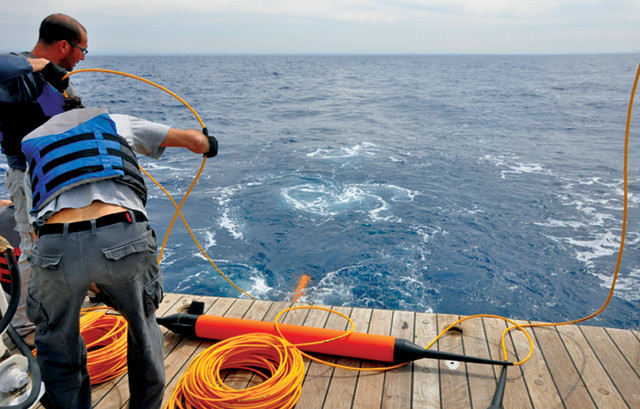
by Kate S. Zalzal Tuesday, December 20, 2016

Scientists deploy equipment to collect magnetic information about crust underlying the eastern Mediterranean Sea. Credit: Roi Granot.
The oldest piece of undisturbed oceanic crust ever discovered has been found beneath the eastern Mediterranean Sea, hidden under more than 10 kilometers of sediment. This ancient crust — estimated at up to 100 million years older than the oldest oceanic crust previously known — could reshape our view of global tectonics and the supercontinent cycle.
Old oceanic crust is typically recycled into the mantle as it is subducted. Ancient ocean crusts formed more than 200 million years ago are preserved only as ophiolites on land. But in the eastern Mediterranean, tectonic plate studies suggested that ancient oceanic crust could remain in place. Seismic data also showed a transition from continental crust to a thinner, igneous crust in the region; however, the thick sediment cover prevented a detailed analysis.
With improved technology and a novel analytical approach, Roi Granot, a marine geologist at Ben-Gurion University of the Negev in Israel, reported in Nature Geoscience that the igneous crust there is, in fact, an in-place remnant of an ancient ocean, possibly formed as long as 340 million years ago.
Granot set out to answer two questions: “What is the nature of this crust — is it continental or oceanic? And what is its age?” he says. “There were many stories about what it was, but no clear evidence for either scenario.”
He collected marine magnetic profiles, including total- and vector-field data, from sensors towed behind ships in the Herodotus and Levant basins. He also looked at new satellite gravity anomaly data. Strong gravity anomalies are characteristic of continental crust and its complex terrains and variable thicknesses, whereas subdued gravity anomalies reflect the homogeneous nature of oceanic crust.
He identified gravity anomaly boundaries and discovered a long sequence of striped magnetic anomalies within the subsurface. These stripes reflect magnetic field reversals; as iron-rich magmas come to the surface and cool along mid-ocean ridges, they record the prevailing global magnetic field direction at the time.
“In the very eastern Mediterranean, just offshore of Israel, Lebanon and Syria, you see continental crust. But then you go into a zone where you don’t see any gravity anomalies, and this is the place where you start to see the magnetic stripes. It’s just a classic transition,” Granot says. These reversal stripes indicate that the crust was formed at an oceanic spreading center.
Next, Granot needed to date the crust, which proved a tougher challenge. The slab crust is too small to correlate with the known geomagnetic reversal timescale, so he took a different approach: using the latitude-dependent shape of the anomalies to estimate the location of the crust when it formed. Granot compared his observations to the expected magnetic signal that would have been created over time as the African Plate moved northward over the past 400 million years. The best match indicates that the crust formed about 340 ± 25 million years ago.
“It was known that this piece of lithosphere was old,” but an age of 340 million years “is a surprise,” says Daniel Pastor-Galán, a paleomagnetist at Utrecht University in the Netherlands who was not involved in the study. There are important assumptions that complicate the age estimate, he says, but even if it’s on the younger end, it still “represents a major discovery that may change many things in our view of Earth evolution.”
If the age estimate proves true, the crust was created when the last supercontinent, Pangea, was still forming. One option, Granot says, is that this crust could be related to the Neotethys Ocean, thought to have formed as Pangea ripped apart, an event previously estimated at 270 million years ago. The older age “suggests that the supercontinent Pangea had started to break apart before it even finished forming,” Granot says.
“Supercontinents are often seen as rigid plates,” says Mark Dekkers, a geophysicist also at Utrecht University who was not involved in this study. “This challenges the current paradigm of supercontinent plate rigidity and prompts re-evaluation … at passive margins where other ‘old’ ocean crust may have been preserved,” he says.
Pastor-Galán says that this work not only pushes the limits of resolution of geophysical techniques, it might also change our view of global tectonics and the supercontinent cycle. “Supercontinents are maybe the final stage of a large-scale geodynamic cycle,” he says. “They could be the key to understanding the full mechanisms of the Earth, and maybe other terrestrial planets.”
© 2008-2021. All rights reserved. Any copying, redistribution or retransmission of any of the contents of this service without the expressed written permission of the American Geosciences Institute is expressly prohibited. Click here for all copyright requests.